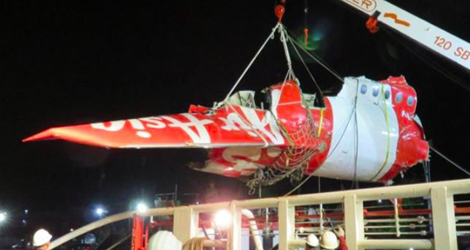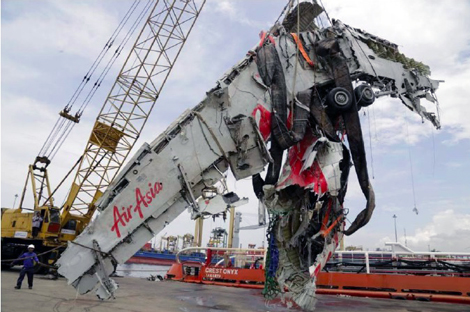
wreckage of Air Asia – Airbus A320-216 (PK-AXC) – flight QZ8501
Air Asia flight QZ8501 crashed on 28 December 2014 : was an Airbus A320-216 aircraft registered as PK-AXC cruising at 32,000 feet on a flight from Juanda Airport, Surabaya, Indonesia to Changi Airport, Singapore with total occupants of 162 persons.
The Pilot in Command (PIC) acted as Pilot Monitoring (PM) and the Second in Command (SIC) acted as Pilot Flying (PF).
The Flight Data Recorder (FDR) recorded that 4 master cautions activated following the failure of the Rudder Travel Limiter which triggered Electronic Centralized Aircraft Monitoring (ECAM) message of AUTO FLT RUD TRV LIM SYS.
the PIC side stick input started to became active with nose down pitch commands and then mostly at neutral while the SIC side stick input was mostly at maximum pitch up until the end of the recording.
The crew performed the ECAM procedure on the first three master caution activations.
After the 4th master caution, the FDR recorded different pilot action and the parameters showed similar signature to those on 25 December 2014 when the FAC CBs were pulled on the ground.
This pilot action resulted on the 5th and 6th master caution activations which correspond respectively to ECAM message of AUTO FLT FAC 1 FAULT and AUTO FLT FAC 1+2 FAULT .
Following two FAC fault, the autopilot and auto-thrust disengaged and the flight control reverted to Alternate Law which means the aircraft lost several protections available in Normal Law.
The aircraft entered an upset condition and the stall warning activated until the end of recording.
Air Asia flight QZ8501 crash-ed after reaching the highest altitude of 38,500 feet and largest roll angle of 104° to the left. Then the aircraft lost altitude with a rate of up to 20,000 feet per minute.
The investigation concluded that contributing factors to this accident were:
- The cracking of a solder joint of both channel A and B resulted in loss of electrical continuity and led to RTLU failure. The existing maintenance data analysis led to unresolved repetitive faults occurring with shorter intervals. The same fault occurred 4 times during the flight.
- The flight crew action to the first 3 faults in accordance with the ECAM messages. Following the fourth fault, the FDR recorded different signatures that were similar to the FAC CB’s being reset resulting in electrical interruption to the FAC’s.
- The electrical interruption to the FAC caused the autopilot to disengage and the flight control logic to change from Normal Law to Alternate Law, the rudder deflecting 2° to the left resulting the aircraft rolling up to 54° angle of bank.
- Subsequent flight crew action leading to inability to control the aircraft in the Alternate Law resulted in the aircraft departing from the normal flight envelope and entering prolonged stall condition that was beyond the capability of the flight crew to recover.
- Issues such as flight approval considered did not contribute to the accident and was not investigated.
Download Report


0 Comments